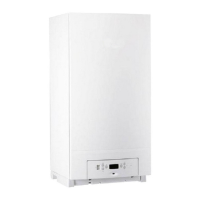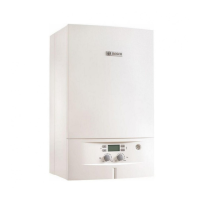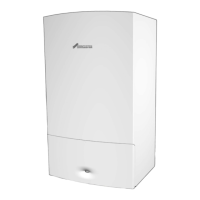Commissioning
Condens 7000 F – 6720871560 (2019/11)
24
7 Commissioning
This chapter describes commissioning using the standard control unit
module.
Before commissioning the boiler, make sure that the cover hood of
the control unit is installed.
After completing the work described below, complete the
commissioning report ( Chapter 17.6, page 63).
NOTICE:
Material damage through excessive dust and dirt contamination in
open flue mode!
Heavy dust and dirt contamination can occur, for example, due to
building work at the installation location.
During building work, operate the boiler in balanced flue mode.
Make sure that the available residual pressure differential is sufficient
for open flue mode.
If room sealed operation is not possible, use the air filter set which is
available as an accessory.
NOTICE:
Risk of boiler damage through contaminated combustion air!
Never use chlorinated cleaning agents or halogenated hydrocarbons
(as contained in spray cans, solvents, cleaning agents, paints and
adhesives, for example).
Never store or use such substances at the installation location.
Burners contaminated during building work must be cleaned before
commissioning.
Inspect flue and combustion air pipe (with room sealed operation)
and combustion air supply and ventilation openings ( Chapter 5.6,
page 17).
7.1 Checking the operating pressure
This boiler cannot be operated with open vented heating systems.
Prior to commissioning, check the operating pressure of the heating
system on the water side and adjust if required.
NOTICE:
Risk of property damage due to unsuitable heating and fill water!
Unsuitable heating and fill water can cause corrosion and scale
formation and/or shorten the service life of the heating system.
Warranty claims for the heat sources will only be considered provided
the water quality requirements have been met and the operator’s log has
been maintained.
Observe the details regarding water quality in the operator's log.
If necessary, treat heating and fill water.
Provide system separation by means of heat exchangers when using
oxygen-permeable pipework (e.g. underfloor heating system).
Set the red needle [1] of the pressure gauge to the required
operating pressure of at least 1 bar.
Fig. 24 Pressure gauge for sealed systems
[1] Red needle
[2] Pressure gauge needle
[3] Green marking
CAUTION:
Health risk through contaminated drinking water!
Observe all country-specific regulations and standards regarding the
prevention of drinking water contamination.
In Europe, observe standard EN 1717. In the UK observe the Water
Supply (water fittings) Regulations 1999.
Top up heating water or drain off water via an approved WRAS
method, until the required operating pressure has been reached.
During filling, vent the heating system via the radiator bleed valves.
7.2 Checking for leaks
Prior to commissioning, check all new line sections on the gas side for
external gas tightness.
DANGER:
Risk of explosion!
If there are leaks in the gas lines and gas connections, there is a danger
of explosion.
Carry out an appropriate leak test with a foaming agent.
NOTICE:
Risk of material damage due to a short circuit!
Liquid on live electrical parts can result in a short circuit.
Prior to carrying out a leak test: cover electrical parts.
Never apply leak detection agent to cable conduits, plugs or electrical
cables/leads.
Ensure that no leak detection agent drips onto electrical parts.
To prevent corrosion, carefully wipe off the leak detection agent
afterwards.
Check the new pipe section, including the joint at the air/gas ratio
control valve, for external tightness. The test pressure at the air/gas
ratio control valve inlet must be no higher than 150 mbar.
If a leak is discovered during this test, all connections must be checked
using a foaming agent. The agent must be approved for gas tightness
testing.
Confirm in the commissioning report that the tightness test has been
carried out.

